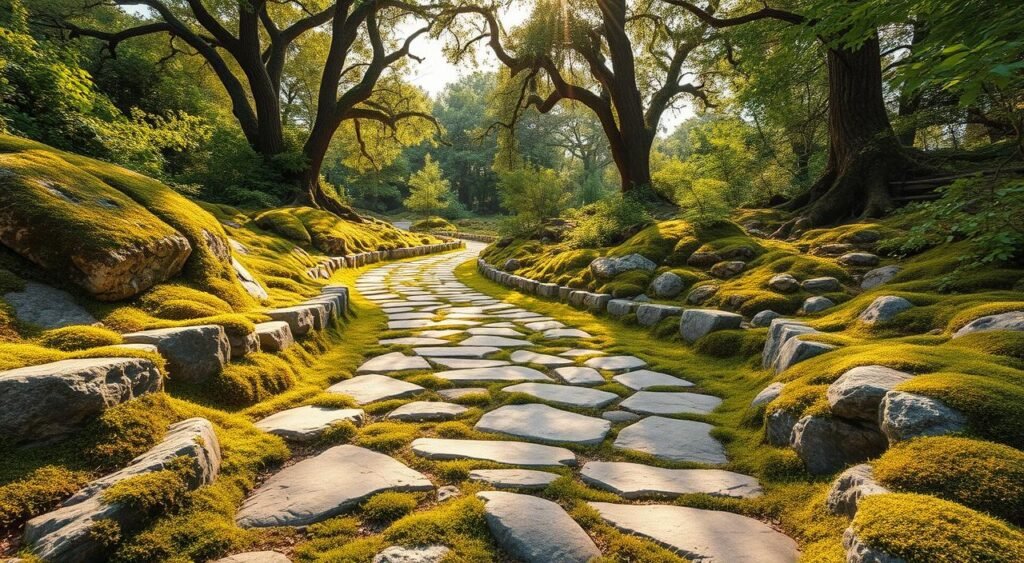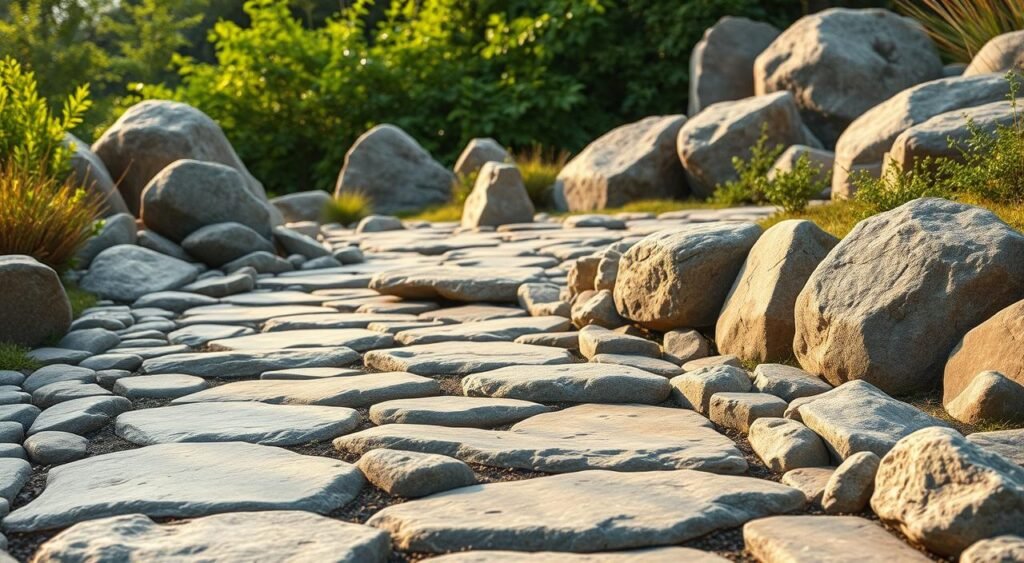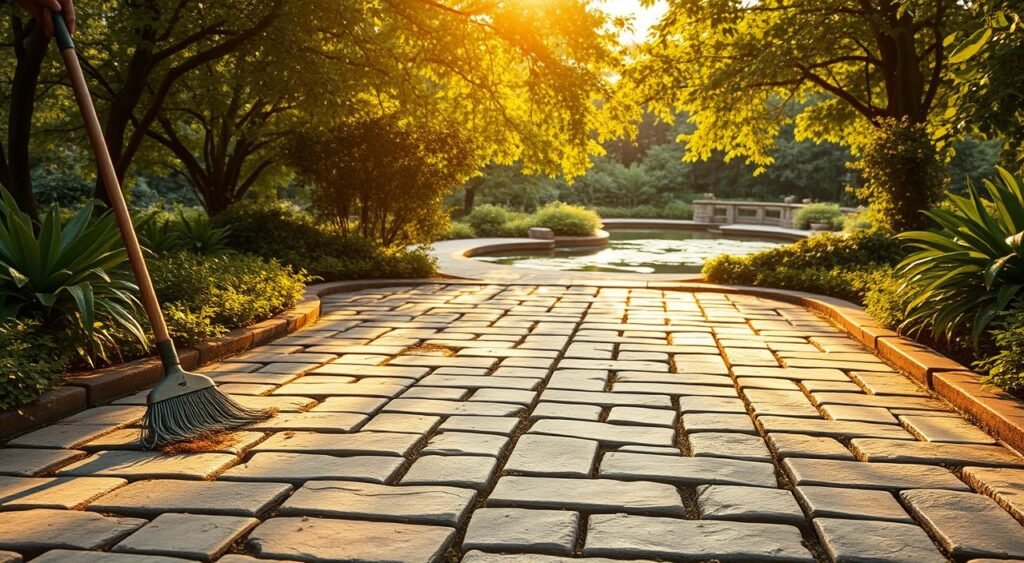Are you tired of muddy trails ruining your garden’s charm? Imagine stepping onto a sleek stone walkway that turns your backyard into a designer-worthy space—without breaking the bank. Stone garden paths aren’t just practical; they’re a game-changer for curb appeal. Let me walk you through how these paths can transform your outdoor space into a sanctuary that’s both beautiful and budget-friendly.
Think stone walkways are too tricky for DIY? Think again! With materials like $8 stepping stones and $5 bags of pea gravel, you can create pathways that look like they belong in a magazine. And guess what? Those gaps between stones? Fill them with creeping thyme or crushed granite for a low-maintenance touch that smells like lavender in summer! This guide will show you exactly how to plan, build, and style paths that last.
Key Takeaways
- Stone garden paths use affordable materials like $8 stepping stones and $5 pea gravel per bag.
- Creeping Thyme and crushed granite fill gaps, adding color and preventing weeds.
- Paths improve safety, curb appeal, and can boost your property’s value.
- Stone walkways work with any style—from modern to cottage gardens.
- Follow this guide to build professional-looking paths without hiring a contractor.
Why Stone Paths Transform Your Garden’s Aesthetic
Imagine stepping onto a path that feels like it belongs exactly where it is. Outdoor stone pathways do more than guide your feet—they become part of the garden’s story. Let’s break down how these paths elevate your space:
The Timeless Appeal of Natural Stone
Natural stone’s irregular edges and earthy tones echo nature’s own artistry. Whether you’re designing a formal garden or a wildflower meadow, landscaping with stones ensures your path never looks outdated. Think sandstone’s warm hues for rustic vibes or slate’s cool gray tones for modern spaces. Pro tip: Mix sizes and shapes to mimic organic patterns found in nature.
How Stone Paths Create Flow in Outdoor Spaces
- Guide visitors toward focal points like water features or seating areas
- Break large spaces into intimate zones with meandering curves
- Use straight lines to emphasize grand garden elements like statues or gazebos
Environmental Benefits of Stone Pathways
Stone isn’t just pretty—it’s a smart choice. Here’s how it outshines alternatives:
| Material | Permeability | Heat Retention | Longevity |
|---|---|---|---|
| Stone | Excellent (allows water absorption) | Moderate (cools faster than asphalt) | 50+ years with proper installation |
| Concrete | Poor (causes runoff) | High (retains summer heat) | 15-20 years |
Stone’s porous surface prevents puddling, cuts down on stormwater runoff, and requires zero chemical treatments. Plus, its durability means less frequent replacements compared to synthetic materials. Ready to start designing? Let’s next explore which stone types suit your style!
Popular Types of Stones for Garden Paths
When selecting the perfect stone for your stone garden paths, it’s essential to align it with your stone path design aspirations. We’ll explore the top choices to help you find the ideal match for your space and budget.

Flagstone: The Classic Choice
Flagstone’s enduring charm comes from its natural layers and earthy hues. It suits both formal and rustic paths, making it versatile. Its durability ensures longevity, but sealing is necessary to prevent stains. Bluestone, a favored flagstone, excels in cold climates due to its resistance to freezing.
For a cohesive look, consider using sand or mortar joints. This will enhance the path’s appearance.
Gravel and Pebbles
Gravel paths are budget-friendly, but they need regular upkeep to stay neat.
Gravel, priced around $5 per bag, is ideal for casual paths. Choose 3/8-inch stones for comfort or 3/4-inch for stability. Seashells can add a coastal flair, being both eco-friendly and vibrant. Ensure the path is bordered with metal edging to prevent stone displacement.
Gravel’s natural drainage is a plus, but avoid areas prone to waterlogging.
River Rocks
River rocks bring a stream-like quality to your garden, adding a touch of drama. Their smooth edges are safe for children, though they may shift over time. Ideal for shaded areas, they won’t burn bare feet like darker stones can.
Manufactured Pavers vs. Natural Stone
- Manufactured pavers: Affordable, uniform, and simple to lay. Concrete pavers start at $1 each but may lose color over time.
- Natural stone: Offers unique textures and colors, such as fieldstone’s rustic appeal. Yet, its irregular shapes can prolong installation times.
Stuck between options? Consider combining materials. Flagstone accents with gravel can create a layered, cost-effective design that’s both sturdy and chic.
Planning Your Perfect Garden Paths with Stones
Planning is where magic starts! Before buying a single stone, map where your family walks most. Think about the front door, kids’ play zones, or your morning coffee spot. These high-traffic spots need the heaviest stones—so pick them first! Your stone garden paths should guide, not just exist.
Begin by spraying chalk outlines or laying garden hoses on the ground to “draw” your path’s shape. Adjust curves until it feels right to your eyes—and your feet.
Start with width: main paths (like a walk to the patio) need 48 inches for two people. Secondary paths (like to the compost bin) can shrink to 30–36 inches. Narrower paths (18–24 inches) work for private spots, like a hidden reading nook.
- Check for dips or roots that could trip your path. Adjust grading before laying stones.
- Match stone size to the space: Larger stones feel grand; smaller ones create whimsy curves.
- Leave gaps between stones for plants! A daisy peeking through flagstone? Pure garden charm.
Natural stone walkways thrive when they fit the garden’s vibe. A straight path feels formal; a winding one feels wild. Ask: Does this guide visitors to your garden’s best views? Does it avoid soggy soil? A little prep stops headaches later.
Sketch on paper or use sticks to test ideas. Need a curve? Walk the route yourself! Your body knows what feels right. Trust your instincts—they’ll make your path feel like home.
Essential Tools and Materials for Stone Path Construction
Ready to start your project? Let’s outline the necessary tools and materials before you begin. Whether you’re creating garden paths with stones or overhauling your landscaping, the right equipment saves time and reduces stress. Let’s begin with a solid foundation!

Must-Have Tools for DIY Path Building
First, gather these essential tools:
- Shovels and spades (for digging)
- Rubber mallet (to tap stones into place)
- A 4-ft level (check even surfaces)
- Knee pads and gloves (protect your hands and knees)
- A tape measure and string line (mark boundaries)
Calculating Stone Quantities Needed
Time for some math! Multiply your path’s length by width to calculate square footage. Add 10–15% extra for cuts. For instance, a 10x2ft path requires 20 sq ft + 20% = 24 sq ft. Gravel costs $0.78–$1.70/sq ft, perfect for budget-friendly projects. Flagstone, on the other hand, costs $6–$10 per stone but lasts for decades. Always round up!
Supplementary Materials for Durability
Don’t overlook these key materials: landscape fabric prevents weeds, crushed gravel provides a stable base, and polymeric sand secures pavers. For simpler paths, a 2” deep sand bed is sufficient. Pro tip: Use edging strips to keep stones in place. Even small details significantly impact long-term results!
Site Preparation: Setting the Foundation for Success
Effective site preparation is key to a successful project. Let’s explore the essential steps to create a solid foundation for your outdoor stone pathways. Begin by mapping out your path’s route with confidence. Here are some professional tips to help you:
Marking Your Path’s Route
- Stretch a flexible garden hose to sketch curves or straight lines.
- Outline edges with lime or flour—flare wider at entry points for a grand entrance.
- Use landscape fabric to block weeds before digging—secure it with 5-inch staples for a solid start.
Proper Drainage Considerations
Drainage is a critical factor for durable stone pathway ideas. Ensure a ¼-inch slope per foot to direct water away. Add a 4-inch gravel layer under pavers to prevent puddling. For areas with frost, include a 2-inch rock dust layer for insulation.
Excavation Techniques for Different Terrains
| Soil Type | Depth | Pro Tip |
|---|---|---|
| Sandy | 4–6 inches | Compact layers in 2-inch increments. |
| Clay | 6 inches | Break up clumps and mix with sand for drainage. |
| Loamy | 5 inches | Perfect balance—add gravel only if slopes are steep. |
For precise work, use a spirit level to ensure evenness. Slightly water the soil before compacting for better binding. Always wear gloves and use a wheelbarrow to move debris efficiently.
Step-by-Step Guide to Installing Garden Paths with Stones
Ready to bring your vision to life? Let’s explore the practical steps to create lasting, stunning garden paths with stones. No need for complicated terms—just straightforward instructions to make your walkway a reality.

- Prepare the base: Start by digging 4–6 inches deep with a flat spade and shovel. Add 2 inches of gravel, then tamp it down firmly. Spread 1 inch of sand on top. This base prevents sinking and ensures even support.
- Arrange stones intuitively: Place your flagstones or pavers on the sand bed. Walk across them to gauge the spacing. Adjust as needed to ensure a natural stride. For paths intended for children, test with smaller steps.
- Secure each stone: Gently tap stones with a rubber mallet to embed them in the sand. Leave ½–1 inch between stones for filler. Use a scrap 2×4 to check for evenness—no wobbles allowed!
- Fill the gaps: Pour pea gravel or polymeric sand into the cracks. Sweep away excess, then mist lightly with water to set the filler. For a softer look, plant creeping thyme or moss in the spaces.
Pro tip: After installation, scatter mulch along the path edges to hide any exposed sand. Step back and admire your handiwork! These stone walkways will not only last but also become the heart of your outdoor space. Need a refresh? Simply lift and reposition stones anytime. Your garden’s new path is now ready to walk, grow, and enjoy!
Creating Patterns and Designs with Stone Placement
Ready to transform your garden path into a masterpiece? Explore stone path design and stone pathway ideas that merge aesthetics with practicality. Whether you desire bold statements or a serene atmosphere, each selection influences the path through your outdoor realm.

Mosaic Techniques for Artistic Paths
Small stones can make a significant impact. Arrange pebbles in floral or geometric patterns, using templates or your own hand for a distinctive flair. Experiment with colors like deep reds or blues for seasonal highlights. A tip: Soaking stones in water enhances their color, adding depth. For a cost-effective option, blend affordable gravel with striking accents.
- Utilize marbles or river rocks for detailed patterns
- Apply mortar in small portions to set fine designs
- Introduce black sand between stones for contrast
Formal vs. Informal Layout Approaches
Deciding between structured grids or organic arrangements? Formal designs excel in symmetry, such as chessboard patterns or brick-like lines. They are ideal for modern gardens, requiring precision but delivering sharp elegance. On the other hand, informal layouts follow nature’s lead, using irregular flagstones or meandering pebble clusters for a cozy, organic feel. Remember, edging materials like brick or metal help keep even wild designs in check.
Incorporate Curves and Straight Lines
Curves encourage exploration—zigzag paths or gentle bends slow your pace, ideal for meditation gardens. Straight paths serve as focal points, like water features or arbors. Combining both offers a balance of purpose and whimsy. Tip: Utilize plywood to align stones, ensuring smooth transitions between lines and arcs.
“The best designs make every step feel intentional.”
Regardless of style, let your path narrate a story. From vibrant mosaics to flowing curves, each choice transforms a walkway into a work of art. Are you ready to begin arranging?
Edging Options to Define Your Stone Pathway
Let’s explore the role of edging in transforming a simple stone path into a work of art. Whether crafting natural stone walkways or stone garden paths, the choice of edging is critical. It not only defines the path’s boundaries but also enhances its aesthetic appeal. Without edging, paths can become disorganized, with gravel spilling over and grass encroaching. Edging prevents this while adding a touch of elegance.

- Metal edging: Offers clean lines and durability, ideal for modern designs. It works best for straight paths, anchored by burying half the strip.
- Brick borders: Create a classic look by stacking bricks vertically along the edges. Red bricks complement gray flagstone beautifully.
- Stone or paver edging: Choose materials that match your path for a seamless look. For example, using river rocks on a gravel path adds instant charm.
- Plastic or recycled rubber: These options are budget-friendly and flexible, perfect for DIY projects on curved paths.
- Living edges: Incorporate creeping thyme or mint between the stones for a softening effect while keeping the path low.
For curved paths, consider using flexible materials like metal or rubber. Straight paths benefit from the crisp lines of brick or stone. Ensure trenches are 4–6 inches deep to secure the edges. Remember, the height of the edging is important; bury half of it to prevent shifting during frost or heavy rain.
Struggling to decide? Consider your garden’s personality. A wild garden might suit fieldstone edging, while a modern space looks better with sleek metal or black plastic. Experiment with different combinations, like gravel paths with flagstone caps, to merge functionality with beauty.
Integrating Your Stone Path with Existing Landscaping
After laying down your outdoor stone pathways, it’s time to make them a seamless part of your garden. Landscaping with stones goes beyond just the path. It’s about achieving harmony between all elements in your garden. We’ll explore smart choices that enhance both beauty and functionality.
Planting Alongside Stone Walkways
Adding plants to stone edges brings life and unity. For busy areas, opt for hardy groundcovers like creeping thyme or sedum. These plants not only thrive but also resist foot traffic. In shaded areas, hostas or ferns create lush contrasts.
For color, consider lavender or dianthys. Remember, plants should complement the path, not dominate it. Letting grass grow over gaps can add a natural, wild touch.

Creating Transitions Between Garden Areas
To guide the eye and footsteps, smooth transitions between areas are key. Use curves to lead to patios or flowerbeds, avoiding sharp angles. Edge paths with metal or stacked stones to prevent mulch from spilling.
For a rustic look, blend gravel borders with flagstone paths. Ensure the path’s slope follows your garden’s natural grade. This allows water to drain away from walkways and into flowerbeds.
Lighting Considerations for Stone Paths
Lighting is essential for safety and ambiance on your stone paths at night. Solar path lights cast a warm glow and highlight the stones’ texture. Uplighting at path ends draws attention to garden highlights like water features.
For a budget-friendly option, string lights through shrubs add ambiance without overwhelming. A few well-placed lights are more effective than many scattered ones.
Maintenance Tips for Long-Lasting Stone Walkways
Ensuring your stone walkways remain in top condition hinges on diligent maintenance. We’ll explore strategies for managing weeds, addressing repairs, and seasonal upkeep. This way, your stone path design will retain its allure for generations to come.

- Spring: Clear debris, check for frost-damaged stones, and relevel any shifted pieces.
- Summer: Scrub algae with Dry Treat’s S-Tech Cleaner—never use vinegar or bleach!
- Fall: Rake leaves daily to prevent staining and inspect drainage after storms.
- Winter: Use calcium chloride ice melt and scrape snow gently with a plastic shovel.
Combatting Weeds: Lay landscape fabric first, then spot-treat with a 50/50 vinegar-water mix. For stubborn growth, spot-apply pre-emergent herbicides twice yearly.
Fixing Damage Fast:
- Reset sunken stones with a pry bar and compact gravel base.
- Replace cracked pieces using a chisel and matching stone scraps.
- Reapply sealant every 3–5 years using professional-grade protectants.
Regular, small tasks can significantly reduce future repair costs. Always prioritize safety—tackle slippery moss with a pressure washer at 3,000 PSI or less in warm weather. Effective maintenance is about being proactive, not about complex projects.
Budget-Friendly Approaches to Stone Path Building
Looking for garden paths with stones without breaking the bank? We’ve got you covered with smart, budget-friendly strategies. Even with a limited budget, you can achieve stunning stone pathway ideas with these tips.

Begin by focusing on cost-effective materials. For example, using stepping stones with pea gravel reduces material needs by 40% while maintaining functionality. Here are ways to maximize your budget:
- Opt for reclaimed bricks or broken pavers from local demolition sites for edging
- Employ landscape fabric to control weeds and prevent gravel from spreading
- Visit salvage yards for discounted flagstone slabs
| Material Option | Cost Range | Key Benefits |
|---|---|---|
| Pea Gravel | $0.50-$1.50/sqft | Easy installation, low maintenance |
| Stepping Stones | $1-$3/stone | Cuts material costs by 30-50% |
| Reclaimed Wood Edging | $10-$25/linear foot | Upcycles materials while defining pathways |
| Creeping Thyme Groundcover | $3-$5/sqft | Natural weed barrier with aromatic bonus |
Renting tools like tampers can save up to $100 compared to buying. Collaborate with friends for labor swaps to reduce costs. Mixing materials is also effective. Combine free river rocks from local streams with affordable pavers for layered stone pathway ideas that are both stylish and budget-friendly.
Investing in quality weed barriers like landscaping fabric is wise. It prevents costly rework in the long run. Focus on durable stones for high-traffic areas and save on base materials. With these strategies, you can create paths that feel luxurious without the high price tag!
Inspiring Stone Pathway Ideas for Different Garden Styles
Let’s dive into creating the perfect stone pathway for your garden. Whether you’re aiming for a cozy cottage vibe, a sleek modern look, or a serene Japanese feel, we’ve got you covered. Explore a variety of stone garden paths and stone pathway ideas to make your garden truly unique.
Imagine turning your garden into a personal sanctuary with stone pathways that reflect your style. Whether you’re drawn to the charm of a cottage, the clean lines of modern design, or the tranquility of Japanese aesthetics, we have the perfect solution. Each garden is a canvas waiting for your personal touch, and stone pathways can be the masterpiece that ties it all together.
Let’s explore some inspiring ideas for stone pathways that will enhance your garden’s style. From winding paths with mismatched stones to sleek, geometric designs, there’s a pathway to suit every taste. Embrace the beauty of nature by incorporating elements like moss-filled gaps and trailing plants into your design.
Looking for a budget-friendly option? Consider using gravel pathways edged with brick or wood. Stepping stones nestled in lawn grass can also add a charming touch without breaking the bank. For a more rustic look, try using recycled concrete pavers in earth tones.

Cobblestones are a timeless choice that can elevate any garden style. Their durability and versatility make them perfect for creating both uniform grids and organic clusters. In cottage gardens, mix different sizes of cobblestones and let plants like lavender or thyme spill between them. Modern spaces can benefit from precision-cut pavers in neutral shades. Japanese-inspired designs, on the other hand, thrive with smooth river rocks and bamboo accents.
Don’t be afraid to experiment and combine different stone pathway ideas to create a path that’s uniquely yours. Whether you’re a seasoned gardener or just starting out, the right stone pathway can transform your garden into a serene oasis. So, are you ready to start creating your dream garden path? It’s just a shovel away!
Common Mistakes to Avoid When Building Stone Garden Paths
There’s so much natural beauty to enjoy with a stepping stone path inset in lush grass. While this option might look like a no-fuss choice, installation will require extra care to ensure the stones are nestled securely within the ground. This avoids your stones from jostling underfoot or becoming tripping hazards.

Creating natural stone walkways is exciting until small oversights turn into big headaches. I’ve seen many DIYers skip important steps. Here’s what to watch out for:
Poor Foundation Prep: The Silent Saboteur
- Ignoring proper base layers (like skipping gravel under pavers) leads to sinking stones and uneven surfaces.
- Forgetting drainage? Water pooling around stone walkways can crack even the toughest materials over time.
- Tip: Use crushed stone, not dirt, as backfill—it’s the secret to long-lasting stability.
Stone Selection Blunders
- Choosing thin stones for high-traffic areas? They’ll chip faster than autumn leaves. Opt for 1.5–2-inch thickness.
- Slippery surfaces? Avoid smooth stones near pools or slopes—safety first!
- Climate counts! In cold zones, skip porous sandstone—it’ll crumble when freeze-thaw cycles hit.
Layout Flops That Spoil the Look
- Skipping patterns? Randomly placed stones create tripping hazards. Use a template or grid to keep spacing consistent.
- Too much creativity? Overly complex designs may look messy if not maintained. Stick to 2–3 stone types max for cohesion.
- Forgetting expansion joints? Stones shift in heat/cold. Leave 1/8–1/4 inch gaps between stones to let them breathe.
These fixes aren’t just technical—they’re about preserving your investment. A well-planned natural stone walkways can last decades. My clients in Portland saved $2k by avoiding these traps. Ready to build smart? Let’s prevent those “Oops, I did it again” moments!
Remember: A little extra effort upfront saves frustration later. Your future self (and your wallet) will thank you!
Common Mistakes to Avoid When Building Stone Garden Paths
There’s so much natural beauty to enjoy with a stepping stone path inset in lush grass. While this option might look like a no-fuss choice, installation will require extra care to ensure the stones are nestled securely within the ground. This avoids your stones from jostling underfoot or becoming tripping hazards.

Creating natural stone walkways is exciting until small oversights turn into big headaches. I’ve seen many DIYers skip important steps. Here’s what to watch out for:
Poor Foundation Prep: The Silent Saboteur
- Ignoring proper base layers (like skipping gravel under pavers) leads to sinking stones and uneven surfaces.
- Forgetting drainage? Water pooling around stone walkways can crack even the toughest materials over time.
- Tip: Use crushed stone, not dirt, as backfill—it’s the secret to long-lasting stability.
Stone Selection Blunders
- Choosing thin stones for high-traffic areas? They’ll chip faster than autumn leaves. Opt for 1.5–2-inch thickness.
- Slippery surfaces? Avoid smooth stones near pools or slopes—safety first!
- Climate counts! In cold zones, skip porous sandstone—it’ll crumble when freeze-thaw cycles hit.
Layout Flops That Spoil the Look
- Skipping patterns? Randomly placed stones create tripping hazards. Use a template or grid to keep spacing consistent.
- Too much creativity? Overly complex designs may look messy if not maintained. Stick to 2–3 stone types max for cohesion.
- Forgetting expansion joints? Stones shift in heat/cold. Leave 1/8–1/4 inch gaps between stones to let them breathe.
These fixes aren’t just technical—they’re about preserving your investment. A well-planned natural stone walkways can last decades. My clients in Portland saved $2k by avoiding these traps. Ready to build smart? Let’s prevent those “Oops, I did it again” moments!
Remember: A little extra effort upfront saves frustration later. Your future self (and your wallet) will thank you!
Expert Tips for Professional-Looking Results
Want your landscaping with stones to impress everyone? Pro installers share secrets that elevate DIY projects into stunning outdoor stone pathways. Begin by placing stones in their final spots to adjust spacing and patterns. A 2-inch sand layer under the stones provides stability without the need for heavy cement.

- Grade paths 1-2% downhill to shed water—no puddles!
- Overlap stone edges slightly to mimic natural erosion
- Re-purpose old bricks or tiles—aged materials add instant character
Pro tip: Visualize from above. Step back and assess lines from various angles. Curved paths should follow gentle “S” shapes, not sharp angles. For tight spaces, use a brick-like pattern to guide the eye smoothly.
| Design Element | Pro Technique |
|---|---|
| Transition zones | Use gravel buffers between plantings and stones |
| Edging | Bury ⅔ of edging materials for seamless integration |
| Stone spacing | Leave ¼” gaps for weed prevention without harsh lines |
Remember, imperfections are your friend. A slightly uneven flagstone path feels more organic than perfectly aligned. For sharp cuts, rent a wet saw with a diamond blade. Always test drainage by pouring water over the base layer before final placement. These small tweaks can transform a good project into a great one. So, go ahead and make your yard the envy of the neighborhood!
Conclusion: Your Journey to Beautiful Stone Garden Paths
Embarking on the journey of creating stone garden paths opens a world of endless possibilities. These pathways serve more than just a purpose; they are a canvas for personal expression and timeless beauty. Whether you opt for the classic elegance of flagstone or the natural allure of river rocks, each choice imbues your space with unique character. Every step, no matter how small, contributes to the overall impact. A simple gravel path or a few stepping stones leading to a bench can significantly enhance your garden’s appeal without straining your resources.
Creating stone garden paths is a delicate balance between meticulous planning and creative freedom. Embrace the imperfections that give your paths a lived-in charm, a trait that professionals highly value. Regular maintenance, such as sweeping and annual inspections, ensures the stones remain secure and the surfaces clean. These paths not only enhance your garden’s beauty but also offer long-term benefits like eco-friendly drainage and increased curb appeal. Ready to start? Begin with a small project, choose your favorite stones, and let your imagination guide you. I’m here to offer any advice on materials or design adjustments to help you create your dream path.
FAQ
What materials are best for creating durable stone paths?
Flagstone is ideal for its timeless appeal. Gravel or pebbles offer an affordable option. River rocks provide a natural look. Manufactured pavers ensure uniformity.
How do stone paths benefit garden aesthetics?
Stone paths enhance garden beauty by guiding movement and linking areas. They complement various garden styles with their natural hues and textures.
What should I consider when planning the layout of my stone path?
Think about traffic flow, connecting features, and path width. Use garden hoses or spray paint to plan the path’s layout before starting.
What tools will I need for building a stone walkway?
You’ll need spades, shovels, levels, and a rubber mallet. Gloves and a wheelbarrow are also essential. String lines ensure straight edges.
How do I ensure proper drainage for my stone path?
Check your area’s natural water flow. Aim for a 1/4 inch slope per foot. Use gravel layers or pipes to avoid pooling and erosion.
What common mistakes should I avoid when installing a stone path?
Avoid poor foundation prep, thin or climate-incompatible stones, and uneven spacing. These can lead to tripping hazards.
How can I enhance the durability of my stone pathways?
Use landscape fabric to suppress weeds. Choose the right edging and ensure a solid base layer. This will extend your path’s life.
Can stone paths be integrated with plants in my garden?
Yes! Plant low-growing, hardy plants to soften the path’s edges. Choose plants based on sun/shade and traffic levels.
What are some inexpensive options for creating a stone pathway?
Use reclaimed stones or remnants from stone yards. Mixing materials can also be cost-effective. Stepping stones with pea gravel look stunning.
How should I maintain my stone paths throughout the seasons?
Regularly check for shifting stones in spring. Manage weeds in summer, clear debris in fall, and remove snow in winter. A seasonal calendar helps with maintenance.
